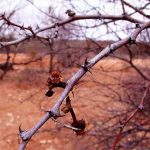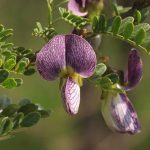TREE LIFE
October 1986
MASHONALAND CALENDAR
Tuesday October 7th : Botanic Garden Walk. Meet at the Car Park at 1645 hours for 1700 hours.
Sunday October 19th : Wedza Mountain. I cannot overemphasize the pleasure associated with seeing the vegetation on Wedza Mountain. Wedza Mountain stands some 1 475ft above the surrounding countryside resulting in a higher rainfall and growth of a number of eastern highlands species. But the geology shows a greater affinity to the dyke than to any of the surrounding granites. Portions of the mountain consist of nickel-toxic serpentine while the ridges are of banded ironstone. On our last visit we found Homalium dentatum, Craibia brevicaudata, Rhus natalensis, Strophanthus speciosus, Chaetachme aristata – need I say more? Bus leaves Monomatapa Car Park at 0800 sharp, please try to arrive by 0745, we have a long way to go. Fare $14.50.
MATABELELAND CALENDAR
On Saturday, October 5th we will go to the Circular Drive. Meet at the Radio Mast South of Fortunes Gate at 0830 hours.
On Sunday September 7th we went to the Lower Umgusa Dam, just below the dam wall. With a combination of good water and a fertile soil, we saw some interesting trees, and the stony ground of some of the valley sides had its interest too. Some 45 varieties were identified, including Acacia chariesa, rather taller than usual.
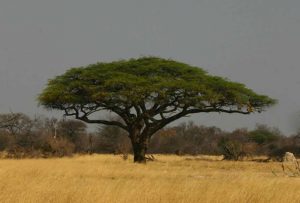
Acacia erioloba. Photo: Bart Wursten. Source: Flora of Zimbabwe
Acacia erioloba, large and imposing on the irrigation lands and flowering heavily Acacia fleckii, Acacia galpinii beginning to flower, A. karroo, A.nigrescens very numerous, flowering well, A. rehmanniana not very happy, Azanza garckeana, Boscia angustifolia of fair size, Cathium lividum, huillense, with largish leaves, those near the dam were probably evergreen and browsed, Carissa edulis, Cassine transvaalensis, Celtis africana, mostly young, Clerodendrum glabrum, Combretum erythrophyllum with much seed, young shoots and even green flower buds, but only very small leaves, Combretum hereroense, Combretum imberbe all rather small, Croton gratissimus, indeed, large patches of rocky hillside were covered with this, to the exclusion of anything else, Dombeya rotundifolia, Euclea diviorum, Gardenia volkensii, Grewia bicolor, Grewia flavescens, Grewia monticola, Maerua, probably M.parvifolia or Maerua edulis, now Courbonia glauca, flowering Maytenus heterophylla, Sclerocarya birrea, smallish, Securidaca longepedunculata, Securinega virosa, Tarchonanthus camphoratus, flowering, Ximenia americana and Ximenia caffra, with very large young leaves Ziziphus mucronata.
At lunch we separated and in the afternoon I went to try and identify some large trees near the irrigation lands and pastures. Where apparently large thickets of Acacia arenaria had been cleared for pasture some large trees had been left. 2 unusually tall Acacia mellifera, showing well the exception to the Rule, that hooked thorns have spiked flowers and straight thorns have globose. Both the trees and the flowers were large and trees being about 10 meters, which is apparently excessive, but as there were nearby several Terminalia sericea also of 10 meters, clearly there was some growth factor present. Also there were some Lonchocarpus capassa with leaves varying a lot in size.
-C.SYKES
BOTANIC GARDEN WALK – SEPTEMBER 2ND 1986
Having been somewhat delayed by the motorcades, both actual and potential, of the NAM Conference, I arrived late for the Botanic Garden Walk to find to my horror that there were none of the usual scribes of Botanic Garden Walks present which left me little option but to borrow pen and notebook and try to record Tom’s every word.
The Acacias which have been the subject of the past few walks were finished off, as we looked at the unusual and rare and the “odd man out”. Tom reminded us that we had first looked at the species with prickles starting with those with many pinnae and many leaflets and working our way through them until we looked at A.nigrescens, knob thorn, which usually only has one pair of pinnae with a single pair of leaflets. We then looked at those with straight thorns, or as they are also called, spinescent stipules, and again started with those with many pinnae and many leaflets and having previously discussed them all, on this occasion we looked at Acacia erioloba, camel thorn, which usually has only 1 or 2 pairs pinnae. This is a tree of the Kalahari Sands in the east of the country and very common in Hwange National Park where being a fairly distinctive tree one does not have to resort to counting pinnae in order to identify it. The Camel thorn, A. erioloba is a tree with a wide spreading crown and straight thorns which often have inflated bases or “ant galls”. They bear yellow globose flowers and large curved grey velvety pods. Tom had hoped to grow a ‘clump’ of these in the Gardens, but unfortunately armillaria has taken its toll and there are only a few left.
Acacia albida, apple ring Acacia, has pale new growth, pale grey trunk and white branchlets often with a zigzag appearance. It is the only acacia which has straight thorns and flowers in spikes, usually it is the species which have prickles like a rose which have elongated flowers. Because of this feature, it has been suggested that this should be in a separate genus Faidherbia. This is another species conspicuous in a well-known resort, this time at Mana Pools where it has adapted to growing on the flood plain, by producing new leaves in the dry season When the area is flooded no air reaches the roots so that is the time when the tree drops its leaves. When the water subsides and there is again air around the roots, new leaves are produced. I have visited Mana a couple of times recently and have been concerned at the lack of regeneration and tended to blame this on the fact that there appear to be too many animals. However, Tom pointed out that Acacias are colonizers and that there are seedlings of A.albida in the dumped sand and gravel pits which have been found as a result of road-making operations so perhaps they cannot establish themselves in competition with other trees but can only do so on bare ground. Acacia polyacantha, Acacia sieberiana and Acacia karroo are the local examples of colonizers and are more often found in open grasslands than in woodland. A. albida is being tried as a tree of arid and low-input type of agriculture areas as it lets in the light, is good as fodder and fuel, and puts nitrogen into the soil; crops cannot really be grown successfully under gum trees.
We then looked at four species which Tom described as shrubby glandular species with straight thorns. They all have slender curved pods, covered with glands, looking like little dots and giving the pods a sticky feel.
A.nebrownii grows between Gwanda and Beit Bridge. It has branches orange to red-brown and leaves with 1 or 2 pairs of pinnae and very few leaflets usually borne tightly clustered on little pods along the branches.
What is called A. exuvialis is found in the southeastern lowveld on rocky outcrops has bigger leaves with more pinnae. The ones growing in Zimbabwe seem to lack the typical flaking bark of the ones which grow in the Transvaal; the bark looks like a Commiphora flaking bark The leaves have 1 to 6 pairs of pinnae with 3 – 6 pairs of leaflets.
Acacia permixta grows on the Fort Tuli hill and the young branches are distinctively and densely covered with greyish hairs and the leaves bear fewer pinnae, 1 – 4 pairs with more leaflets, 5 – 10 pairs.
A.borleae without hairs and with leaves having more pinnae and more leaflets grows only on basalt and is found in the southeast of the country.
To complete the picture there are two other glandular shrubby species which occur in South Africa. Acacia tenuispina and Acacia swazica have very papery pods and slightly larger leaves than the other glandular species. Lynnette Davidson says that the leaflets of all the glandular species have a small spine on the apex which distinguishes them from A.karroo.
Finally, we looked at two very unusual species, Acacia stuhlmannii of which there are a few stands along the Gwanda to Beit Bridge road. Tom described it as looking like an Acacia sieberiana but having very hairy branchlets, lenticels and a peeling green under bark. It is described by both Carr and Ross as being obconical, upside down cone, and is usually a multi stemmed shrub but can also be a tree to 7.5m and has spinescent stipules and leaves with 4 – 12 pairs of pinnae, each with 6 – 12 pairs leaflets.
Acacia kirkii with the yellowish brown bark peeling to reveal a green under bark is a species of the Zambezi Valley particularly around the Chiwore River mouth and on old lands. This is a straight-spined species and the leaves have 6 – 14 pairs pinnae with numerous tiny leaflets.
And in the dusk as we wandered back to our cars we passed under a magnificent spreading Acacia robusta still covered in flower although many had fallen and formed a carpet for our feet.
Thank you Tom, believe it or not, the Acacia picture is becoming clearer and I am sure all of us have found that our understanding of how to identify them is a little better than it was before.
-Meg Coates Palgrave
USASA FARM AND SARUWE RIVER – SUNDAY 21st SEPTEMBER 1986
On previous botanic garden walks, Tom has casually referred to the “Basement Complex”, a term I have only recently begun to understand. The Basement Complex consists of the oldest rocks in Zimbabwe and these formed while they were deep down below the surface but have since been exposed due to erosion. Strangely enough because of buckling of the earth’s crust these old rocks now form the middle and Highveld of Zimbabwe. The lowveld areas generally consist of younger sediments and rocks that were deposited on top of the Basement Complex.
There are two important elements in the Basement Complex. The greenstone belts and the younger granitic rock that welled up into the greenstones, assimilating some and pushing other areas aside. This granite solidified underground and now forms large granite dwalas like those we saw last month beyond Makumbe Mission I have always associated granite with fertile soils but that was in areas where the quartz in the rock goes into solution fairly rapidly, forming fine sand which, with other minerals that weather to nutrient-rich clays, results in high fertility. Locally the situation is different, the nutrient-rich clay is washed away before the quartz breaks down resulting in infertile sandy soils and the typical trees we saw last month. The greenstone belts form different soils with more clay and are often richer, although within these belts there are many soil types as the geology is complex. Chegutu lies on a greenstone belt and this, together with the lower altitude, results in exciting vegetation.
We saw so much in one day I can only really skim over the highlights. Having left Harare and traveled through miombo woodland with its typical Brachystegia – Julbernardia association, we stopped at an Acacia patch beyond Norton. A stand of A.polyacantha displayed their white bark while A.karroo and the fine-leaved A.rehmanniana had red bark. Tom taught us to identify A.nilotica by its anastomosing bark and so far it seems to work well. Both A.sieberiana and A. gerrardii are common along this road and on the way home we examined the grove of enormous A.galpinii on the Harare side of Norton these trees were in full flower with spikes of purple calyces breaking out into light yellow sprays.
A short way along the Seigneury Road we crossed the first outcrop of ironstone of the Chegutu greenstone belt. Here Maureen spotted a Gardenia volkensii in full flower, its long calyx tubes and lack of a rusty powder differentiate it from the many G.ternifolia we saw on Usasa. At the Brierley’s farmhouse we were welcomed with a superb tea and a great social gathering that spilled out into the garden to examine fine specimens of Combretum zeyheri, C.collinum, C.hereroense and C.molle all together and in fruit. In the afternoon we were all fooled by a C.imberbe on the south side of the road bridge alongside the Saruwe River. The long shoots were armed with pairs of sharply pointed short shoots and in an opposite decussate arrangement. The leaves come off both short and long shoots.
Although we now seldom have trouble separating Cassine matabelica from C.aethiopica, I never remember which name applies to which. Phil points out that C.matabelica looks like Catha edulis whereas C.aethiopica resembles Maytenus undata, and no one muddles Catha with M.undata. We saw large specimens of C.matabelica on Usasa, and then found both growing alongside each other at Saruwe. At a tall Ochna schweinfurthiana Ann Bianchi taught us two new facts, firstly, that this species can produce a mass of flowers like those we have seen before in O.pulchra, the specimens in Phil’s garden flower sporadically and secondly, we learned the delightful word tessellated to describe the bark of this species. The word comes from tesserae, the small blocks used in mosaic.
There was so much to see, and we still had not arrived on the jasper. On an anthill we saw a large Capparis tomentosa, a leafless Berchemia discolor and a small Tricalysia junodii subsp. kirkii, in Coates Palgrave as T. allenii. The leaf base is shallowly lobed and the leaf is softly furry. I would have overlooked the specimen had Meg not recognized it on our last visit.
Arriving on the jasperlite we had much to do and find and people all went fossicking off. We learned about banded jasper, picture jasper and found some amazing colours. Around us were the tall Haplocoeum foliolosum Meg mentioned last month, and the peeling bark of Euphorbia espinosa. We were pleased to have Gill Masterson with us to enjoy rediscovering Maerua friesii in full flower. Gill had originally discovered this species on a neighbouring farm as a new record for the country. In the Flora it is only listed from the forests and Baikiaea woodlands of Tanganyika, Zaire, Zambia and Malawi. Some leaves have a distinct swelling at the top of the petiole, something like that in Cola, whereas other specimens were only furry all over. Also on the jasper was Rothmannia fischeri in flower and fruit, and Hippocratea parvifolia in fruit.
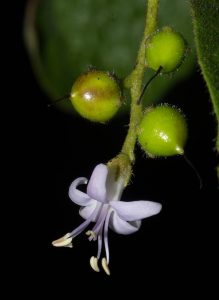
Ehretia obtusifolia. Photo: Bart Wursten. Source: Flora of Zimbabwe
We headed back to the farmhouse for lunch and were rewarded with a huge Ehretia obtusifolia in full flower on an anthill. With so much left unseen we said farewell to the Chegutu folk and headed home. We really must thank the Brierleys for all their hospitality and the Bianchis as well, the puddings were superb. On route we stopped at a spectacular Lonchocarpus capassa in full flower and a magnificent wild wisteria, Bolusanthus speciosus also in full bloom; this tree had obviously fallen off its antheap but had then sent up new shoots. In clambering over the fence I found a tall straggling Maerua later identified as Maerua juncea subsp. juncea. We stopped on the Dyke at Saruwe River where we found Tarchonanthus camphoratus, a rare find although Meg has recently discovered some specimens in the Mukuvisi Woodlands. This species is one of the few members of the daisy family with sexes on different plants. Nearby is a grove of Terminalia randii with their pornographic short shoots that stick up vertically from the horizontal branches. The little grove of Bolusanthus was in flower, although no one tree stood out as prominently as the one we had seen earlier in the day. Other finds were Nuxia oppositifolia and Bob decided our specimen was Vangueria randii On the road home both Molly and I spotted a spectacular white flowering Bolusanthus on the south side of the road just on the Selous side of the grassland that marks the eastern edge of the Great Dyke. It joined the ever-increasing list of “things to return to, one day.
-Kim Damstra
LEARNERS’ OUTING TO CORO PARK ON SATURDAY 20TH SEPTEMBER 1986
A small group of interested members assembled at Gill Masterson’s on this fresh spring morning and were taken to Coronation Caravan Park, Msasa.
On arrival the cars were parked underneath a large Ficus sur laden with ripe fruit which carpeted the ground beneath, in fact, there was hardly a place to tread without standing on the figs. We spent a while looking at the huge smooth green ovate leaves before moving off to examine Erythrina abyssinica sporting the very pretty scarlet 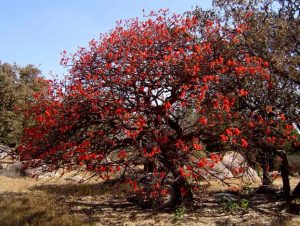 flowers which seem to have been blooming spectacularly all over Zimbabwe for months now. Gill explained that they have trifoliate leaves, completely glabrous, smooth bark when young which splits when it grows and is often seen cultivated in Harare gardens.
flowers which seem to have been blooming spectacularly all over Zimbabwe for months now. Gill explained that they have trifoliate leaves, completely glabrous, smooth bark when young which splits when it grows and is often seen cultivated in Harare gardens.
Next, we saw Ozoroa insignis subsp. reticulata and it was interesting to see how rolled the edges are of the strongly veined velvety under surfaces of the leaves. There was some young growth of Celtis africana hanging next to it. This tree, also known as white stinkwood, had me completely foxed – I was thinking of Ziziphus mucronata and Gill also suggested a similarity with Grewia. We saw that the serrations of these alternate leaves cease halfway down either side, being uneven at the base and tapering to fairly pointed tips.
We had a brief stop at a Cassine aethiopica bearing what looked like last year’s dark rather dreary-looking leaves with characteristic tiny sharp-toothed margins and were able to see it was sprouting new growth in places.
A number of Cussonia arborea were noted and new spikes of flower starting to come through. It was fun to see last year’s dried ‘octopi’ wedged at odd angles. Flacourtia indica proved hard to identify even with typical fairly smooth leaves and slightly toothed margins, until we found the odd spine. There was an enormous Ficus sycomorus and we were able to feel the rough upper surface of the leaves and see the distinctive pale yellowish trunk which distinguishes it from F. sure (capensis). Pavetta gardeniifolia was examined very closely and apart from the black dots which could be seen even without holding the leaf up to the light we were shown the interpetiolar stipule at the base of the leaf stalk which is the giveaway. It was pointed out that all RUBIACEAE have this feature together with opposite paired leaves. We had no difficulty in recognizing the monkey orange but did not know which one until told that this was Strychnos spinosa because of its roughish grey bark, that S.cocculoides has a corky bark and S.innocua a smooth bark almost like F.sycomorus.
An amusing incident took place when our eyes alighted on what looked like animal droppings on the ground but on lifting our eyes skywards, the sight of a few dried digitate leaves of the Vitex payos revealed them to be chocolate berries!
Skipping briefly now through some of the others we saw trifoliate Rhus longipes, Diospyros lycioides, star apple, some very showy Cassia singueana thickly covered in bright yellow blossom and in contrast a very dried-up thicket of Dichrostachys cinerea which obligingly yielded one cluster of pods to confirm identification. We collected snot apple fruit from underneath a sizeable Azanza garckeana and turned over the three to five lobed hairy leaves to examine the ‘burst pipes’. The yellow sweet-scented flowers of Combretum molle made a high canopy on this tall tree, contrasting strongly with the somewhat stolid appearance of a nearby Parinari curatellifolia, widely known as muhacha or mobola plum.
A short stop was taken to examine the flowers of Vangueriopsis lanciflora which are rather similar to Turraea nilotica which Common Trees of the Central Watershed Woodlands of Zimbabwe tells us flower at the same time and are often found growing together.
A number of Acacia sieberiana grow within the park and it was a good opportunity to try to absorb again what we are learning about acacia family. Gill told us that those with round flowers have straight thorns and those bearing spiked flowers have curved thorns except in the case of Acacia albida, which had both.
The striking red flowers of a cultivated Combretum microphyllum caught our attention. Occurring naturally in warmer areas such as Shamva and Macheke this one had obviously been planted in this spot.
We had a most informative morning and we are grateful to Gill for her time and efforts, not to mention the excellent coffee and cream cakes provided afterwards back at the base under the fig tree. Most enjoyable, thank you, Gill.
-Marjorie Barker
The notes promised in last month’s newsletter will appear next month.
KIM DAMSTRA CHAIRMAN


